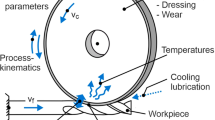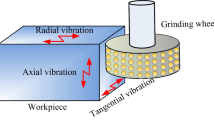Abstract
This study investigates the grinding process of the common grinding wheel under nanoparticle jet flow minimal quantity lubrication. This study establishes a kinematics model, elastic deformation model, and plastic accumulation model of a single grinding wheel, simulates the grain distribution on the surface of the common grinding wheel by using the grain vibration method, and examines the effect of different grinding parameters on the surface topography of the workpiece. Results show that the peaks and valleys on the profile curve of the workpiece surface increase and the corresponding R a and R z heights decrease, as the peripheral velocity of the grinding wheel increases. The peaks and valleys on the profile curve of the workpiece surface decrease, and the corresponding R a and R z heights increase as the feed speed of the workpiece increases. The number of grinding cracks on the surface of the workpiece decreases, the length of each crack increases, and the bump height on the surface increases slightly as the grinding depth increases. Experiments are conducted to verify the simulation results. The results show that the simulation method can predict the surface roughness of the workpiece, which is a factor in selecting the grinding parameters.
Similar content being viewed by others
References
Nguyen TA, Butler DL (2005) Simulation of precision grinding process, part 1: generation of the grinding wheel surface. Int J Mach Tools Manuf 45(11):1321–1328
Brinksmeiera E, Mutlugünes Y, Klocke F, Aurich JC, Shore P, Ohmori H (2010) Ultra-precision grinding. CIRP Ann Manuf Technol 59(2):652–671
Mao C, Zou H F, Huang Y, Li Y F, Zhou Z X (2013) Analysis of heat transfer coefficient on workpiece surface during minimum quantity lubricant grinding. Int J Adv Manuf Technol 66:363–370
Xu X, Malkin S (2001) Comparison of methods to measure grinding temperatures. J Manuf Sci Eng 123(2):191–195
Barczak LM, Batako ADL, Morgan MN (2010) A study of plane surface grinding under minimum quantity lubrication (MQL) conditions. Int J Mach Tools Manuf 50(11):977–985
Heinemann R, Hinduja S, Barrow G, Petuelli G (2006) Effect of MQL on the tool life of small twist drills in deep-hole drilling. Int J Mach Tools Manuf 46(1):1–6
Mao C, Zhou ZX, Zhang J, Huang XM, Gu DY (2011) An experimental investigation of affected layers formed in grinding of AISI 52100 steel. Int J Adv Manuf Technol 54(5):515–523
Jin T, Stephenson DJ (2008) A study of the convection heat transfer coefficients of grinding fluids. CIRP Ann Manuf Technol 57(1):367–370
Malkin S, Guo C (2007) Thermal analysis of grinding. CIRP Ann Manuf Technol 56(2):760–782
Li CH, Hou YL, Xiu SC, Cai GQ (2008) Application of lubrication theory to near-dry-green grinding—feasibility analysis. Adv Mater Res 135(4):44–46
Davim JP, Sreejith PS, Gomes R, Peixoto C (2006) Experimental studies on drilling of aluminium (AA1050) under dry, minimum quantity of lubricant, and flood-lubricated conditions. Proc Inst Mech Eng B J Eng Manuf 220(10):1605–1611
Khan MMA, Mithu MAH, Dhar NR (2009) Effects of minimum quantity lubrication on turning AISI 9310 alloy steel using vegetable oil-based cutting fluid. J Mater Process Technol 209(15):5573–5583
Mao C, Tang X J, Zou H F, Zhou Z X, Yin W W (2012) Experimental investigation of surface quality for minimum quantity oil–water lubrication grinding. Int J Adv Manuf Technol 59(1–4):93–100
Tawakoli T, Hadad MJ, Sadeghi MH, Daneshi A, Stöckert S, Rasifard A (2009) An experimental investigation of the effects of workpiece and grinding parameters on minimum quantity lubrication—MQL grinding. Int J Mach Tools Manuf 49(12/13):924–932
Sadeghi MH, Haddad MJ, Tawakoli T, Emami M (2009) Minimal quantity lubrication-MQL in grinding of Ti–6Al–4V titanium alloy. Int J Adv Manuf Technol 44(5–6):487–500
Morgan MN, Barczak L, Batako A (2012) Temperatures in fine grinding with minimum quantity lubrication (MQL). Int J Adv Manuf Technol 60:951–958
Weinert K, Inasaki I, Sutherland JW, Wakabayashi T (2004) Dry machining and minimum quantity lubrication. CIRP Ann Manuf Technol 53(2):511–537
Wen D S, Lin G P, Saeid V, Zhang K (2009) Review of nanofluids for heat transfer applications. Particuology 7(2):141–150
Li C H, Li J Y, Wang S, Zhang Q (2013) Modeling and numerical simulation of the grinding temperature field with nano-particle Jet of MQL. Volume 2013:Article ID 986984, 9 pages
Mohammadjafar H, Banafsheh S (2012) Thermal analysis of minimum quantity lubrication-MQL grinding process. Int J Mach Tools Manuf 63(12):1–15
Li CH, Hou YL, Liu ZR, Ding YC (2011) Investigation into temperature field of nano-zirconia ceramics precision grinding’. Int J Abras Technol 4(1):77–89
Shen B, Shih AJ, Tung SC (2008) Application of nanofluids in minimum quantity lubrication grinding. Tribol Trans 51(6):730–737
Cheol C, Mihee J, Youngmin C, Jaekeun L, Jemyung O (2011) Tribological properties of lubricating oil-based nanofluids with metal/carbon nanoparticles. J Nanosci Nanotechnol 11(1):368–371
Hwang Y, Park HS, Lee JK, Jung WH (2006) Thermal conductivity and lubrication characteristics of nanofluids. Curr Appl Phys 6:e67–e71
Mao C, Zou H F, Zhou X, Huang Y, Gan H Y, Zhou Z X (2014) Analysis of suspension stability for nanofluid applied in minimum quantity lubricant grinding. Int J Adv Manuf Technol 71:2073–2081
Sethuramalingam P, Vinayagam BK (2012) AFM investigation in grinding process with nanofluids using Taguchi analysis. Int J Adv Manuf Technol 60:149–160
Li C H, Wang S, Zhang Q, Jia D Z (2013) Evaluation of minimum quantity lubrication grinding with nano-particles and recent related patents. Recent Patents Nanotechnique 7(2):167–181
Gong YD, Wang B, Wang WS (2002) The simulation of grinding wheels and ground surface roughness based on virtual reality technology. J Mater Process Technol 129(1):123–126
Su C, Hou J, Wang W (2008) Research and development of simulation system for virtual grinding. Comput Sci Comput Technol 1:409–412
Sakakura M, Tsukamoto S, Fujiwara T, Inasaki I (2008) Visual simulation of the grinding process. Proc Inst Mech Eng B J Eng Manuf 222(10):1233–1239
Salisbury EJ, Domala KV, Moon KS, Miller MH, Sutherland JW (2001) A three-dimensional model for the surface texture in surface grinding, part 1: surface generation model. J Manuf Sci Eng 123(4):576–581
Salisbury EJ, Domala KV, Moon KS, Miller MH, Sutherland JW (2001) A three-dimensional model for the surface texture in surface grinding, part 2: grinding wheel surface texture model. J Manuf Sci Eng 123(4):582–590
Chakrabarti S, Paul S (2008) Numerical modeling of surface topography in superabrasive grinding. Int J Adv Manuf Technol 39:29–38
Li X, Rong Y (2011) Framework of grinding process modeling and simulation based on microscopic interaction analysis. Robot Comput Integr Manuf 27(2):471–478
Li X (2010) Modeling and simulation of grinding processes based on a virtual wheel model and microscopic interaction analysis. Worcester Polytech Inst 4:38–78
Zhou X, Xi F (2002) Modeling and predicting surface roughness of the grinding process. Int J Mach Tools Manuf 42(8):969–977
Nguyen TA, Butler DL (2005) Simulation of surface grinding process, part 2: interaction of the abrasive grain with the workpiece. Int J Mach Tools Manuf 45(11):1329–1336
Hou ZB, Komanduri R (2003) On the mechanics of the grinding process—part I. Stochastic nature of the grinding process. Int J Mach Tools Manuf 43(15):1579–1593
Liu Y M, Andrew W, Bauer R, Gong Y D (2013) Investigation of different grain shapes and dressing to predict surface roughness in grinding using kinematic simulations. Precis Eng 37(3):758–764
Wang S, Li C H, Zhang Q (2013) Evaluation of grinding performance in minimum quantity lubrication with nano-particles. Manuf Tech Mac Tool 2:86–89
Zhang Q, Li C H, Wang S (2013) Analysis of cooling characteristic for minimum quantity lubrication with nanoparticles. Manuf Tech Mac Tool 3:91–96
Author information
Authors and Affiliations
Corresponding author
Rights and permissions
About this article
Cite this article
Wang, S., Li, C., Zhang, D. et al. Modeling the operation of a common grinding wheel with nanoparticle jet flow minimal quantity lubrication. Int J Adv Manuf Technol 74, 835–850 (2014). https://doi.org/10.1007/s00170-014-6032-z
Received:
Accepted:
Published:
Issue Date:
DOI: https://doi.org/10.1007/s00170-014-6032-z




